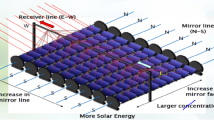Abstract
In the solar tower power plant, the receiver is one of the main components of efficient concentrating solar collector systems. In the design of the receiver, the heat flux distribution in the cavity should be considered first. In this study, a numerical simulation using the Monte Carlo Method has been conducted on the heat flux distribution in the cavity receiver, which consists of six lateral faces and floor and roof planes, with an aperture of 2.0 m×2.0 m on the front face. The mathematics and physical models of a single solar ray’s launching, reflection, and absorption were proposed. By tracing every solar ray, the distribution of heat flux density in the cavity receiver was obtained. The numerical results show that the solar flux distribution on the absorbing panels is similar to that of CESA-I’s. When the reradiation from walls was considered, the detailed heat flux distributions were issued, in which 49.10% of the total incident energy was absorbed by the central panels, 47.02% by the side panels, and 3.88% was overflowed from the aperture. Regarding the peak heat flux, the value of up to 1196.406 kW/m2 was obtained in the center of absorbing panels. These results provide necessary data for the structure design of cavity receiver and the local thermal stress analysis for boiling and superheated panels.
Similar content being viewed by others
References
Yu Qizheng, Pan Yingchun, Zhang Donghui. Monte Carlo simulation of radiative heat transfer character in anisotropic medium. Journal of Engineering Thermophysics, 1996, 17(1): 96–100
Chen Y, Liou K N. A Monte Carlo method for 3D thermal infrared radiative transfer. Journal of Quantitative Spectroscopy & Radiative Transfer, 2006, 101(1): 166–178
Wong B T, Mengüç M P. Monte Carlo methods in radiative transfer and electron-beam processing. Journal of Quantitative Spectroscopy & Radiative Transfer, 2004, 84(4): 437–450
Walters D V, Buckius R O. Monte Carlo methods for radiative heat transfer in scattering media. In: Annual Review of Heat Transfer. 1994, 5: 131–176
Gentile N A. Implicit Monte Carlo diffusion—An acceleration method for Monte Carlo time-dependent radiative transfer simulations. Journal of Computational Physics, 2001, 172(2): 543–571
Howell J R. Application of Monte Carlo to heat transfer problems. In: Hartnett J P, Irvine T F, eds. Advances in Heat Transfer. Vol. 5. New York: Academic Press, 1968
Modest MF. Radiative Heat Transfer, 2nd ed. New York: Academic Press, 2003
Tang Heping. Numerical Simulation of Infrared Radiation Character and Transmission. Harbin Institute of Technology Press, 2006
Ruan Liming, Hao Jinmo, Tang Heping. Monte Carlo method to radiative transfer in two-dimensional scattering rectangular enclosures. Journal of Combustion Science and Technology, 2002, 8(5): 390–394
BakerA F, Faas S E, RadosevichL G, Skinrood A C, Peire J, Castro M, Presa J L. US-Spain Evaluation of the Solar One and CESA-I Receiver and Storage Systems. Sandia National Laboratories, USA, 1989
Author information
Authors and Affiliations
Corresponding author
Rights and permissions
About this article
Cite this article
Wang, Y., Dong, X., Wei, J. et al. Numerical simulation of the heat flux distribution in a solar cavity receiver. Front. Energy Power Eng. China 4, 571–576 (2010). https://doi.org/10.1007/s11708-010-0019-8
Received:
Accepted:
Published:
Issue Date:
DOI: https://doi.org/10.1007/s11708-010-0019-8



